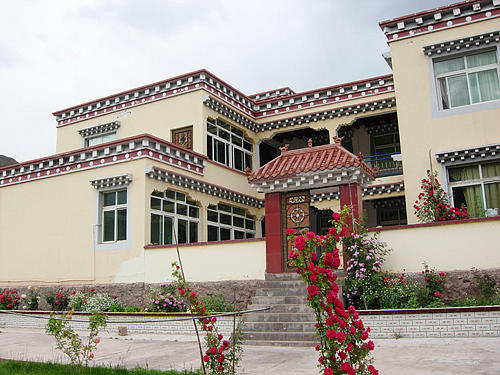|
 |
|
HOME, SWEET HOME: A new house built with government subsidies in a village in Qamdo Prefecture, Tibet (WANG JUN) |
Changing lives
A large portion of Tibet's population used to reside in mountainous regions and valleys, disconnected from the outside world due to a lack of roads and inaccessible to electricity and safe drinking water. Most people didn't have telephones, televisions or even radios. It was therefore difficult to provide education, social security benefits and medical services for these scattered people.
"In some areas, you can ride a bus for four or five hours without seeing a single house," said Dawa Samdup, director of the office responsible for rural housing programs of Tibet. "A child from a nomadic family who goes to Lhasa to attend school may be unable to find his or her way home when returning during school breaks."
Usually made of wood and clay, with flimsy foundations but without earthquake-protective facilities, houses in rural areas can be amazingly hazardous, Dawa Samdup said.
"After scattered farmers and herdsmen are relocated, the costs for infrastructure construction, such as water, power, water, gas and cable TV systems, have been reduced," said Dawa Samdup.
In 2006, the Tibet Regional Government carried out a new program, including reconstructing existing houses, settling of nomadic people and relocating people from poverty-stricken areas. So far, it has benefited 1.4 million people.
Moving into houses not only provides a healthier living environment for rural Tibetans, it also provides peace of mind.
Dawa Samdup said farmers now spend more time working outside the confines of their homes. Some run their own guesthouses in tourist areas; others are engaged in the transportation industry.
In Enda, the per-capita annual net income of villagers more than doubled the 2004 level to 5,200 yuan ($805) in 2010.
With better infrastructure, farmers and herdsmen have more channels to learn about life outside Tibet.
"For example, through radios, televisions and telecommunications services, farmers can learn more about farming techniques and expand the market for their products. They are learning new ways to sell their vegetables now," Dawa Samdup said.
Educational facilities have also improved. For example, the primary school, which used to have three grades, now have six grades providing a proper primary school education, Vice Headmaster Pema Sahjen, told Beijing Review.
"The improvement of housing conditions has played a very important role in raising living standards and boosting infrastructure construction in rural Tibet, increasing income of farmers and herdsmen and promoting stability of the agricultural and pastoral areas," Dawa Samdup said.
Greater ambitions
Between 2006 and 2010, 17 billion yuan ($2.63 billion) was invested in a variety of housing programs in Tibet. Since Tibet is located in a quake-prone area of the world, the regional government invested another 2 billion yuan ($309.76 million) in reinforcing existing houses.
In 2010, Tibet launched a pilot program to build village libraries, cultural and sports facilities, village-based broadcasting networks and movie theaters. It also began building convenient stores in rural areas and improving village clinics, public lighting systems, road networks, rural garbage and sewage disposal facilities and landscape projects. Investment in the pilot program totaled 527 million yuan ($81.62 million) in 2010, of which 346 million yuan ($53.59 million) was offered by the regional government.
In the five years beginning 2011, the pilot program will be extended to 4,953 villages with a budget of 5.1 billion yuan ($789.90 million), said Dawa Samdup.
Funds for Housing Program in Tibet (2006-10)
- 3.84 billion yuan ($594.73 million) from regional government
- 451 million yuan ($69.85 million) from prefecture-level governments
- 253 million yuan ($39.18 million) from county-level governments
- 328 million yuan ($50.80 million) from aid funds of other provinces and municipalities
- 9.3 billion yuan ($1.44 billion) from farmers and herdsmen themselves
- 2.91 billion yuan ($450.69 million) from loans by financial institutions
(Source: Tibet Regional Government) | 